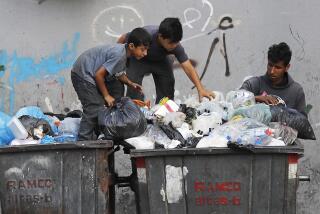Beleaguered Racetrack in Beirut Reopens to Cheers
- Share via
BEIRUT — A record turnout of more than 25,000 cheering fans packed bullet-scarred stands Sunday as Arabian steeds raced again in Beirut for the first time in almost five years.
The track sits on the former no-man’s land of Beirut’s now-dismantled Green Line, which divided the city into Christian and Muslim sectors.
The resumption of racing was trumpeted by the Lebanese media as a milestone in government efforts to reunite the capital. Throughout Lebanon’s 15-year civil war, the track has been a frequent target.
“This is a day to remember, a moment of thrill,” said millionaire sportsman Henry Faroun, 92, founder of the racetrack and chairman of the committee that runs it.
Thousands of Muslims and Christians, rich and poor, shouted cheers of “May God prolong your life” and “God bless you” as attendants carried Faroun, bedridden for seven months with a broken hip, to the committee’s glassed-in tower.
“It has been my dream to see the horses racing again in Beirut before I die. That dream has come true,” Faroun told reporters. “The track is a prime symbol of national unity.”
The first race was won by Saif al-Amir, Arabic for Sword of the Prince, owned by Christian businessman Antoine Kashouh.
The committee announced through loudspeakers that racing sessions will be held every Sunday until there are enough trained horses to race twice a week.
Government troops and riot police patrolled the racetrack to maintain order.
In the old days, up to 10,000 people used to gather at the wooden hippodrome to bet on races at the oval 1,600-yard course. Politics were never discussed at the track, founded in 1916 during Ottoman rule.
The track’s governing committee takes pride that theirs is the only track that races only the Arabian breed. Thoroughbreds are prohibited.
When the civil war broke out in April, 1975, the track and its stands were seriously damaged and it was closed for two years.
It was reopened in 1977, when the Syrian army intervened to snuff out the fighting, even though snipers from both sides still fired from shell-pocked apartment buildings overlooking the track.
The first race that year was won by a white Arabian named Simsam, or Sword, despite a gunshot wound to the neck.
The track was repeatedly caught in the cross fire after that, and closed again.
During a brief opening in 1979, gunmen opened up on the horses lined up for the annual Christmas race, then raked the crowded stands, wounding three spectators.
When the Israeli army invaded and besieged Beirut’s Muslim sector in 1982, 120 horses were killed and most of the surrounding pine woods were set on fire in the fighting.
Races resumed late in 1983.
The track was closed again in February, 1985, when a militia commander fired three grenades into the air over the stands, reportedly because the committee refused to pay him protection money.
In November, Christian and Muslim militias withdrew from the capital in compliance with the peace plan sponsored by the Arab League, leaving the army in control of Beirut. That paved the way for the track’s reopening.
More to Read
Sign up for Essential California
The most important California stories and recommendations in your inbox every morning.
You may occasionally receive promotional content from the Los Angeles Times.













